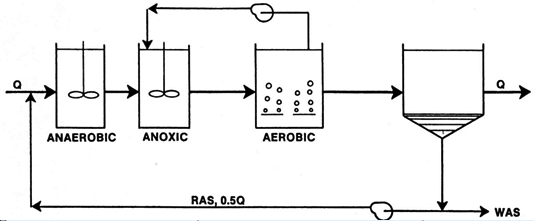PAO – organisms with the ability to “store” polyphosphates as energy reserve inside the cell. When faced with abundant organics, they use bound energy (phosphate) to adsorb/absorb organics for later use. Other organisms can store soluble organics, so the key to phosphorus removal is having the correct mix of organic acids and an anerobic/nitrate free zone before moving to an aerobic zone. Once the environmental conditions are correct in A2O and other biological phosphorus removal systems PAO specific organisms become favored – most common in WWTP is Candidatus accumulibacter.
C. accumulibacter releases phosphorus to fuel the uptake of short chain VFA which are produced by anaerobic metabolism of soluble BOD by bacteria in either the collection system to a lesser extent in the anaerobic digester (methane production reduces VFA concentrations). Long residence time collection systems will yield needed VFA. However, odor control programs using nitrate can prevent VFA as well as H2S formation. Also, if nitrate makes it to the anaerobic zone, PAO organisms will have competition from NRB.
PAO organism populations can be monitored using molecular tools like other biological nutrient removal cultures. We have noticed that PAO populations drift with changes in residence times, VFA concentrations, and nitrate/nitrite levels. Using a Microbial Community Analysis test for periodic monitoring helps operations improve system control.
Interesting note – aerobic/NRB bacteria in aerobic WW systems also use a similar organics uptake/storge mechanism. In conventional activated sludge systems, we see Thauera & Zooglea genera which uptake soluble organics near the influent, store the organics in EPS, and use the EPS to fuel growth in lower F/M conditions that exist outside the influent zone. It is when you don’t have enough time with low F/M that the EPS continues to build creating non-filamentous or zoogleal bulking.
Key Points to Promote PAO Growth
- PAO are favored when you combine VFA & Anaerobic (nitrate free) conditions before an aerobic zone.
- Phosphorus is released by the cells in the anaerobic zone and uptake soluble phosphorus in the aerobic zone.
- Need to ensure sufficiently low nitrate/nitrite in the return MLSS to the anaerobic zone.
- Check influent VFA concentrations – you must have enough to promote the unique PAO metabolism.


 RSS Feed
RSS Feed